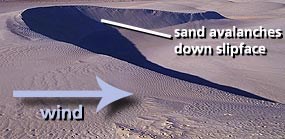
NPS/Fred Bunch Great Sand Dunes National Park contains different types of dunes, each explained below through images and animations. Each dune type is the result of different wind patterns, and the presence or lack of vegetation on the ground.

NPS This is the predominant type of dune in the dunefield. The predominate wind direction is from the southwest, but storm winds off the mountains from the northeast flip the crest of the dunes backward, forming a sharp ridge. 
NPS/Great Sand Dunes NPP Star Dunes Where star dunes are present, an area's wind regime is complex. Star dunes form only in places where wind blows from varied directions over the course of a year. At Great Sand Dunes, a large star dune complex occurs in the northeast corner of the dunefield. The tallest dune at Great Sand Dunes is 750' (229m), and known simply as The Star Dune. 
NPS/David Zelenka Parabolic Dunes Much of the sand sheet is covered with vegetation. If strong winds erode a section of the vegetated sand (commonly referred to as a blowout), a parabolic dune may form. Leeward motion occurs if sand from the blowout is deposited on the opposite slope of the parabolic dune. Vegetation holds the "arms" of the dune in place as the leeward "nose" of the dune migrates forward toward the main dunefield. Parabolic dunes are common in the sand sheet southwest of the main dunefield. 
NPS/Great Sand Dunes NPP On the sand sheet, parabolic dunes are still migrating today toward the main dunefield. Vegetation on the valley floor causes them to become parabolic dunes rather than barchan dunes (below). 
NPS/Patrick Myers Barchan Dunes If conditions were "perfect"—the landscape was flat, winds blew from only one direction, vegetation could not grow, and sand was available but limited —barchan dunes would dominate a sandscape. Since those conditions are rarely found at Great Sand Dunes, a very complex dune system emerges. Even so, classic barchan dunes can be found at various locations throughout the park. Look for classic barchan dunes directly across from the main Dunes Parking Area. As the sand supply increases, barchan dunes begin to connect with others forming barchanoid ridges. If the ridges become fairly straight, scientists call them transverse dunes (below). 
NPS/Patrick Myers Transverse Dunes Barchan dunes (above) can become aligned together along a plane perpendicular to the wind. If the line becomes somewhat straight, dune scientists refer to these forward marching ridges as transverse dunes. They progress forward as their leeward slipfaces release sand one avalanche at a time. Along the southern boundary of the dunefield, a series of transverse dunes are fed by recycled sand transported by Medano Creek. 
NPS/Andrew Valdez Nebkha or Coppice Dunes Nebkha dunes (also known as coppice dunes) are simple dunes that form around vegetation, primarily on the sand sheet. Clumps of shrubs and grass begin to gather windblown sand; as the sand gets deeper, the plants also grow taller, allowing more sand to gather around them. |
Last updated: March 5, 2024
